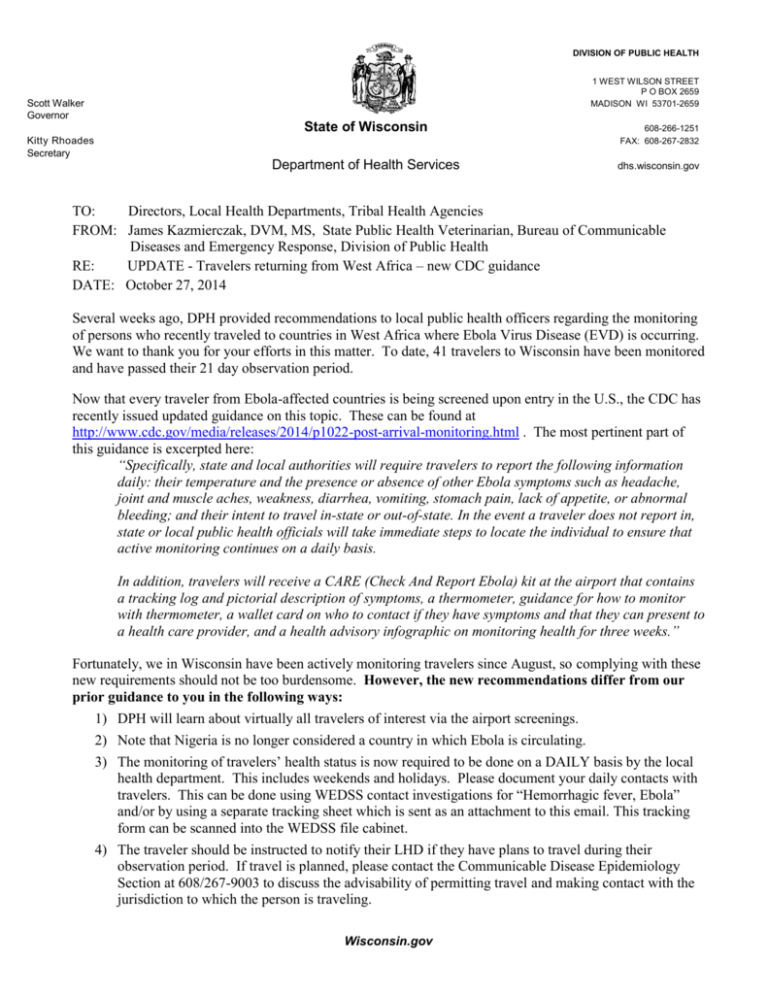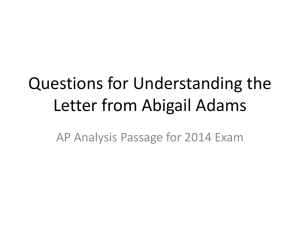Returning Traveler Guide
advertisement

DIVISION OF PUBLIC HEALTH 1 WEST WILSON STREET P O BOX 2659 MADISON WI 53701-2659 Scott Walker Governor State of Wisconsin 608-266-1251 FAX: 608-267-2832 Department of Health Services dhs.wisconsin.gov Kitty Rhoades Secretary TO: Directors, Local Health Departments, Tribal Health Agencies FROM: James Kazmierczak, DVM, MS, State Public Health Veterinarian, Bureau of Communicable Diseases and Emergency Response, Division of Public Health RE: UPDATE - Travelers returning from West Africa – new CDC guidance DATE: October 27, 2014 Several weeks ago, DPH provided recommendations to local public health officers regarding the monitoring of persons who recently traveled to countries in West Africa where Ebola Virus Disease (EVD) is occurring. We want to thank you for your efforts in this matter. To date, 41 travelers to Wisconsin have been monitored and have passed their 21 day observation period. Now that every traveler from Ebola-affected countries is being screened upon entry in the U.S., the CDC has recently issued updated guidance on this topic. These can be found at http://www.cdc.gov/media/releases/2014/p1022-post-arrival-monitoring.html . The most pertinent part of this guidance is excerpted here: “Specifically, state and local authorities will require travelers to report the following information daily: their temperature and the presence or absence of other Ebola symptoms such as headache, joint and muscle aches, weakness, diarrhea, vomiting, stomach pain, lack of appetite, or abnormal bleeding; and their intent to travel in-state or out-of-state. In the event a traveler does not report in, state or local public health officials will take immediate steps to locate the individual to ensure that active monitoring continues on a daily basis. In addition, travelers will receive a CARE (Check And Report Ebola) kit at the airport that contains a tracking log and pictorial description of symptoms, a thermometer, guidance for how to monitor with thermometer, a wallet card on who to contact if they have symptoms and that they can present to a health care provider, and a health advisory infographic on monitoring health for three weeks.” Fortunately, we in Wisconsin have been actively monitoring travelers since August, so complying with these new requirements should not be too burdensome. However, the new recommendations differ from our prior guidance to you in the following ways: 1) DPH will learn about virtually all travelers of interest via the airport screenings. 2) Note that Nigeria is no longer considered a country in which Ebola is circulating. 3) The monitoring of travelers’ health status is now required to be done on a DAILY basis by the local health department. This includes weekends and holidays. Please document your daily contacts with travelers. This can be done using WEDSS contact investigations for “Hemorrhagic fever, Ebola” and/or by using a separate tracking sheet which is sent as an attachment to this email. This tracking form can be scanned into the WEDSS file cabinet. 4) The traveler should be instructed to notify their LHD if they have plans to travel during their observation period. If travel is planned, please contact the Communicable Disease Epidemiology Section at 608/267-9003 to discuss the advisability of permitting travel and making contact with the jurisdiction to which the person is traveling. Wisconsin.gov Page 2 – Wisconsin Division of Public Health, 10/24/14 5) Health departments are now charged with attempting to locate travelers who fail to check in daily to ensure monitoring continues. 6) Because of these changes in guidance, note that the form on the last page of this memo has changed. Please discard the prior sets of guidance that were sent and dated 8/19/14 and 9/4/14 and use this current one. Thank you for your assistance in this matter. Please direct any questions to the CDES staff at 608/267-9003. Detailed information on the Ebola outbreak and guidance for clinicians, hospitals, and laboratories can be found on the DHS website at http://www.dhs.wisconsin.gov/communicable/diseasepages/ViralHemorrhagicFevers.htm Page 3 – Wisconsin Division of Public Health, 10/24/14 Ebola Virus Disease: Questions for persons with recent travel to West Africa Instructions: Obtain the information below and confirm the countries and dates of travel. Traveler’s name _________________________________________ Date of Birth ________________ Address ____________________________________________________________________________ Phone (home and cell) ________________________________________________________________ Workplace / School __________________________________________________________________ Emergency contact and phone __________________________________________________________________ Country visited ___________________________________ From ____/____/____ to ____/____/____ If the traveler did not visit Guinea, Sierra Leone, or Liberia*, or if travel occurred over 21 days ago, the interview can be terminated and the traveler reassured that they are unlikely to have been infected with Ebola Virus. Contact the Division of Public Health to let us know this person does not require monitoring. If the traveler did visit one of these countries within the past 21 days, please complete the rest of this form. List potential exposures that occurred in West Africa (check all that apply): Contact with a possible case of EVD Worked as health care worker Participated in funeral Household contact of a possible EVD case Direct contact with bats or non-human primates None of the above Other (describe)__________________________________________________________________________ Is traveler currently ill? Y N If yes, date of illness onset ____/____/____ highest measured temp __________o Fever Y N Headache Y N Vomiting Y N Diarrhea Skin rash Y N Unusual or unexplained bleeding Y N Y N Other (describe)__________________________________________________________________________ Has traveler seen a medical provider ? Y N If yes, name & location of provider and date of visit _______________________________________________ Did anyone else travel with you? If yes, note names and their contact information on a separate page. Interviewer’s name and phone # ______________________________________________________ *Check CDC website ( http://www.cdc.gov/vhf/ebola/ ) for most current list of countries with active EV transmission. -- more -- Page 4 – Wisconsin Division of Public Health, 10/24/14 Follow up Actions After Completing Interview IF TRAVELER IS NOT ILL AND HAS NONE OF THE POTENTIAL RISK FACTORS: 1) Inform traveler that your agency will need to monitor him/her through 21 days after traveler left the endemic country. This should be done daily via telephone. Instruct the traveler to monitor their temperature twice daily (morning and evening) and to report any fever or illness to your agency immediately. 2) Inform traveler that these daily check-ins are not optional and that if your attempts to contact him/her are unsuccessful, you are obligated to make attempts to locate the traveler via workplace, schools, neighbors, etc. 3) Instruct traveler that he/she is currently under no movement restrictions, but will need to inform you of any travel plans to ensure that the daily check-ins can continue. If traveler has plans for out of state travel, inform DPH. 4) The LHD should document the results of the daily check-ins. This can be done using WEDSS contact investigations for “Hemorrhagic fever, Ebola” (see the “Ebola monitoring” tab) and/or by using a separate tracking sheet which can be found on the last page of this form. This tracking sheet can be scanned into the WEDSS file cabinet. IF TRAVELER IS NOT ILL BUT HAS ANY OF THE POTENTIAL RISK FACTORS: 1) Consult with DPH regarding the need to impose restrictions on the traveler’s movements. 2) The daily monitoring as described above will still be necessary. IF TRAVELER IS ILL: 1) Obtain a brief description of the traveler’s symptoms, when illness began, and presence of fever. 2) Ask traveler where they would go if a medical evaluation was indicated. 3) If, in your opinion, the illness constitutes an emergency, let the person know that 911 should be contacted. The LHD should call 911 to ensure that the 911 operator is told that transport is required for a patient with potential Ebola virus disease. 4) If emergency transport is not required, instruct the person to remain at home where he will be contacted soon by DPH staff for further instructions. 5) Notify the DPH IMMEDIATELY about an ill traveler. Phone 608/258-0099 (24/7 emergency answering service) and ask to speak to the communicable disease person who is on-call. You may be asked to suggest a regional facility at which the traveler can be medically evaluated. Name: End of 21-day monitoring period (date): Last exposure date: WEEK 1 Day: DAY 1 DAY 2 Date: AM PM AM Time of check: Temperature (°F or °C) Other symptoms (circle Y for Yes or N for No) Headache Y N Y N Y N Joint or muscle aches Y N Y N Y N Weakness Y N Y N Y N Diarrhea Y N Y N Y N Vomiting Y N Y N Y N Stomach pain Y N Y N Y N Lack of appetite Y N Y N Y N Rash Y N Y N Y N Red eyes Y N Y N Y N DAY 3 DAY 4 DAY 5 DAY 6 DAY 7 PM AM PM AM PM AM PM AM PM AM PM Y Y Y Y Y Y Y Y Y Y Y Y Y Y Y Y Y Y Y Y Y Y Y Y Y Y Y Y Y Y Y Y Y Y Y Y Y Y Y Y Y Y Y Y Y Y Y Y Y Y Y Y Y Y Y Y Y Y Y Y Y Y Y Y Y Y Y Y Y Y Y Y Y Y Y Y Y Y Y Y Y Y Y Y Y Y Y Y Y Y Y Y Y Y Y Y Y Y Y N N N N N N N N N N N N N N N N N N N N N N N N N N N N N N N N N N N N N N N N N N N N N N N N N N N N N N N N N N N N N N N N N N N N N N N N N N N N N N N N N N N N N N N N N N N N N N N N N N N WEEK 2 Day: DAY 8 DAY 9 Date: AM PM AM Time of check: Temperature (°F or °C) Other symptoms (circle Y for Yes or N for No) Headache Y N Y N Y N Joint or muscle aches Y N Y N Y N Weakness Y N Y N Y N Diarrhea Y N Y N Y N Vomiting Y N Y N Y N Stomach pain Y N Y N Y N Lack of appetite Y N Y N Y N Rash Y N Y N Y N Red eyes Y N Y N Y N DAY 10 DAY 11 DAY 12 DAY 13 DAY 14 PM AM PM AM PM AM PM AM PM AM PM Y Y Y Y Y Y Y Y Y Y Y Y Y Y Y Y Y Y Y Y Y Y Y Y Y Y Y Y Y Y Y Y Y Y Y Y Y Y Y Y Y Y Y Y Y Y Y Y Y Y Y Y Y Y Y Y Y Y Y Y Y Y Y Y Y Y Y Y Y Y Y Y Y Y Y Y Y Y Y Y Y Y Y Y Y Y Y Y Y Y Y Y Y Y Y Y Y Y Y N N N N N N N N N N N N N N N N N N N N N N N N N N N N N N N N N N N N N N N N N N N N N N N N N N N N N N N N N N N N N N N N N N N N N N N N N N N N N N N N N N N N N N N N N N N N N N N N N N N WEEK 3 Day: DAY 15 DAY 16 Date: AM PM AM Time of check: Temperature (°F or °C) Other symptoms (circle Y for Yes or N for No) Headache Y N Y N Y N Joint or muscle aches Y N Y N Y N Weakness Y N Y N Y N Diarrhea Y N Y N Y N Vomiting Y N Y N Y N Stomach pain Y N Y N Y N Lack of appetite Y N Y N Y N Rash Y N Y N Y N Red eyes Y N Y N Y N DAY 17 DAY 18 DAY 19 DAY 21 PM AM PM AM PM AM PM AM PM AM PM Y Y Y Y Y Y Y Y Y Y Y Y Y Y Y Y Y Y Y Y Y Y Y Y Y Y Y Y Y Y Y Y Y Y Y Y Y Y Y Y Y Y Y Y Y Y Y Y Y Y Y Y Y Y Y Y Y Y Y Y Y Y Y Y Y Y Y Y Y Y Y Y Y Y Y Y Y Y Y Y Y Y Y Y Y Y Y Y Y Y Y Y Y Y Y Y Y Y Y N N N N N N N N N N N N N N N N N N N N N N N N N N N N N N N N N N N N N N N N N N N N N Health department name and contact: Phone (daytime): DAY 20 Phone (night/weekend): N N N N N N N N N N N N N N N N N N N N N N N N N N N N N N N N N N N N N N N N N N N N N N N N N N N N N N






